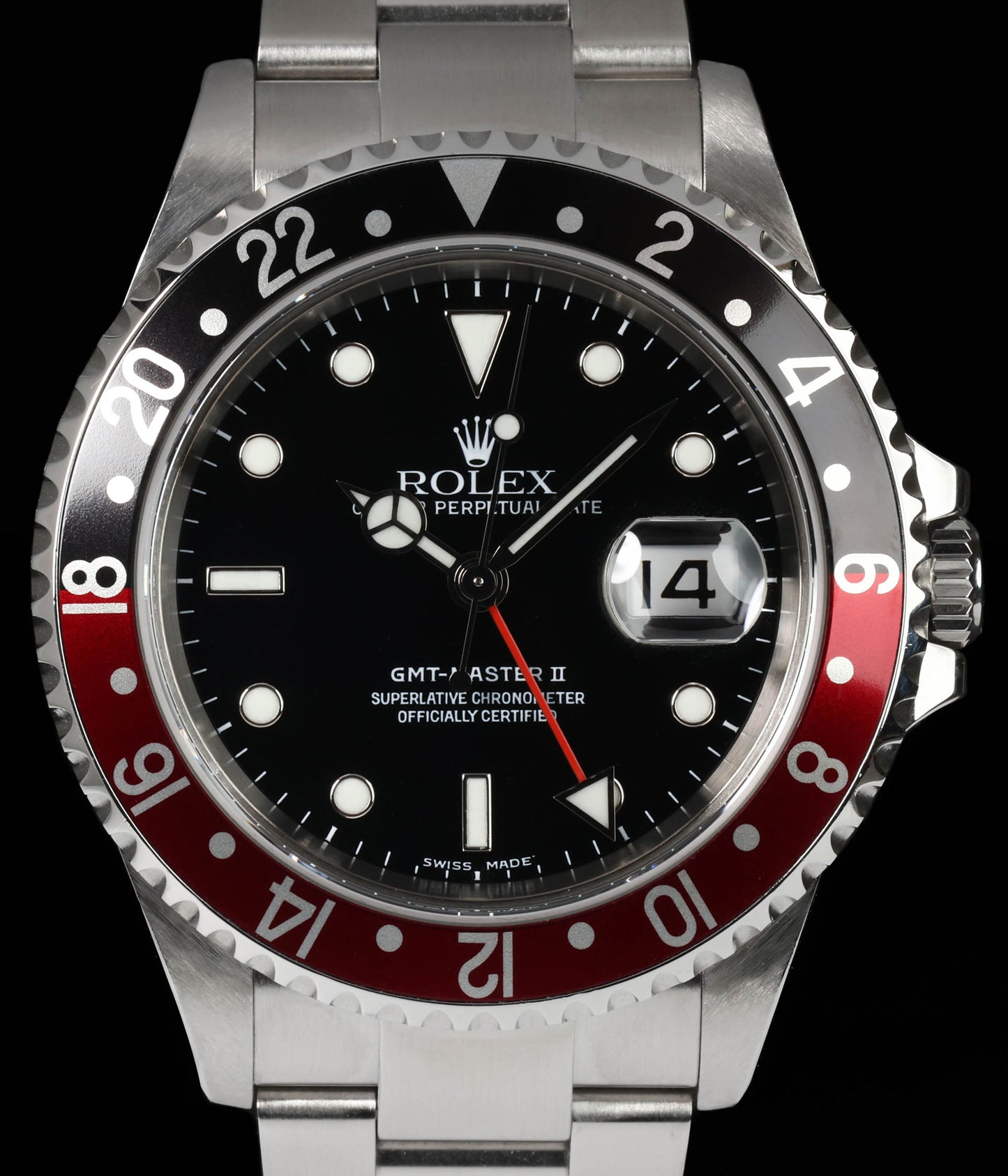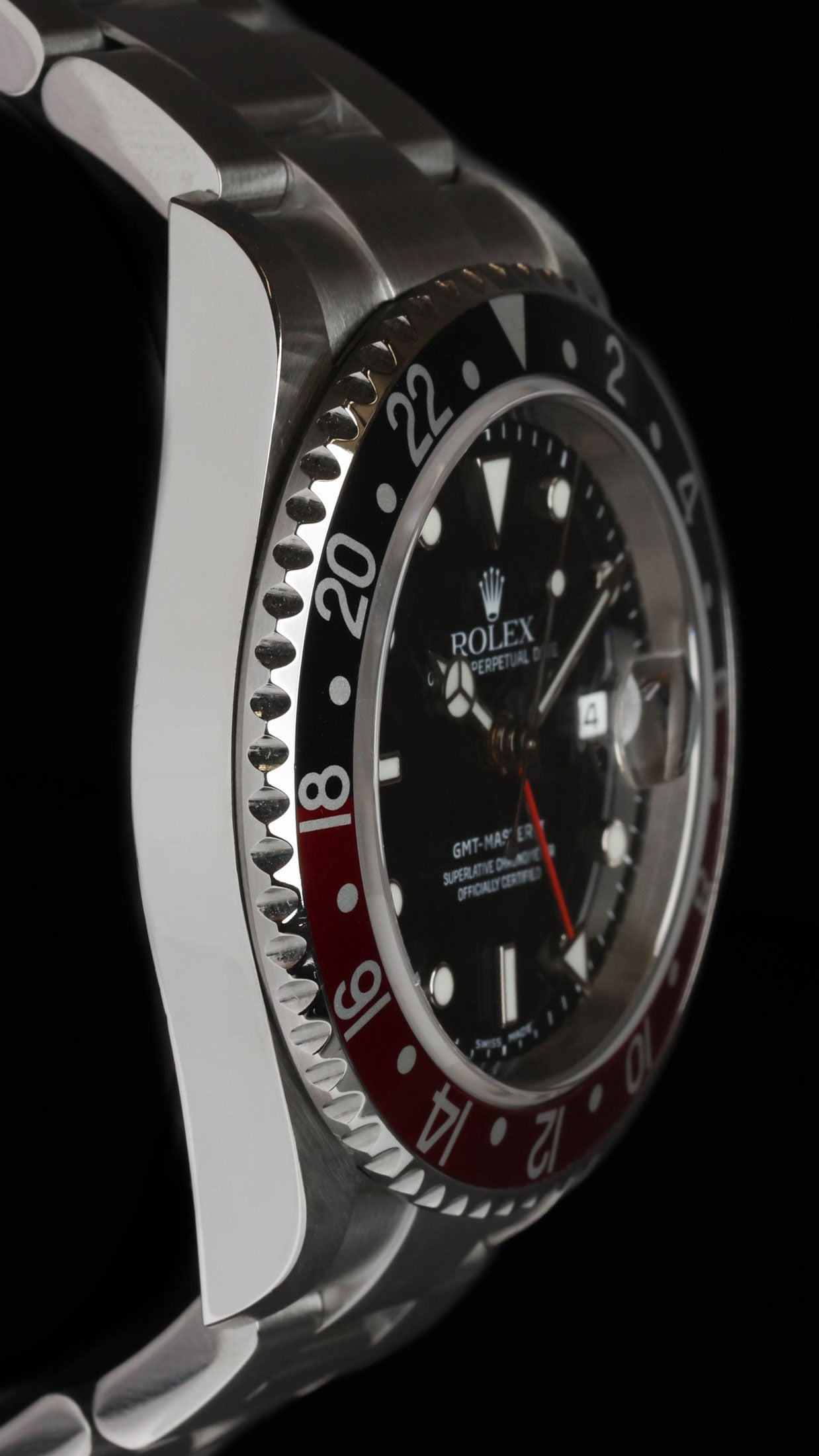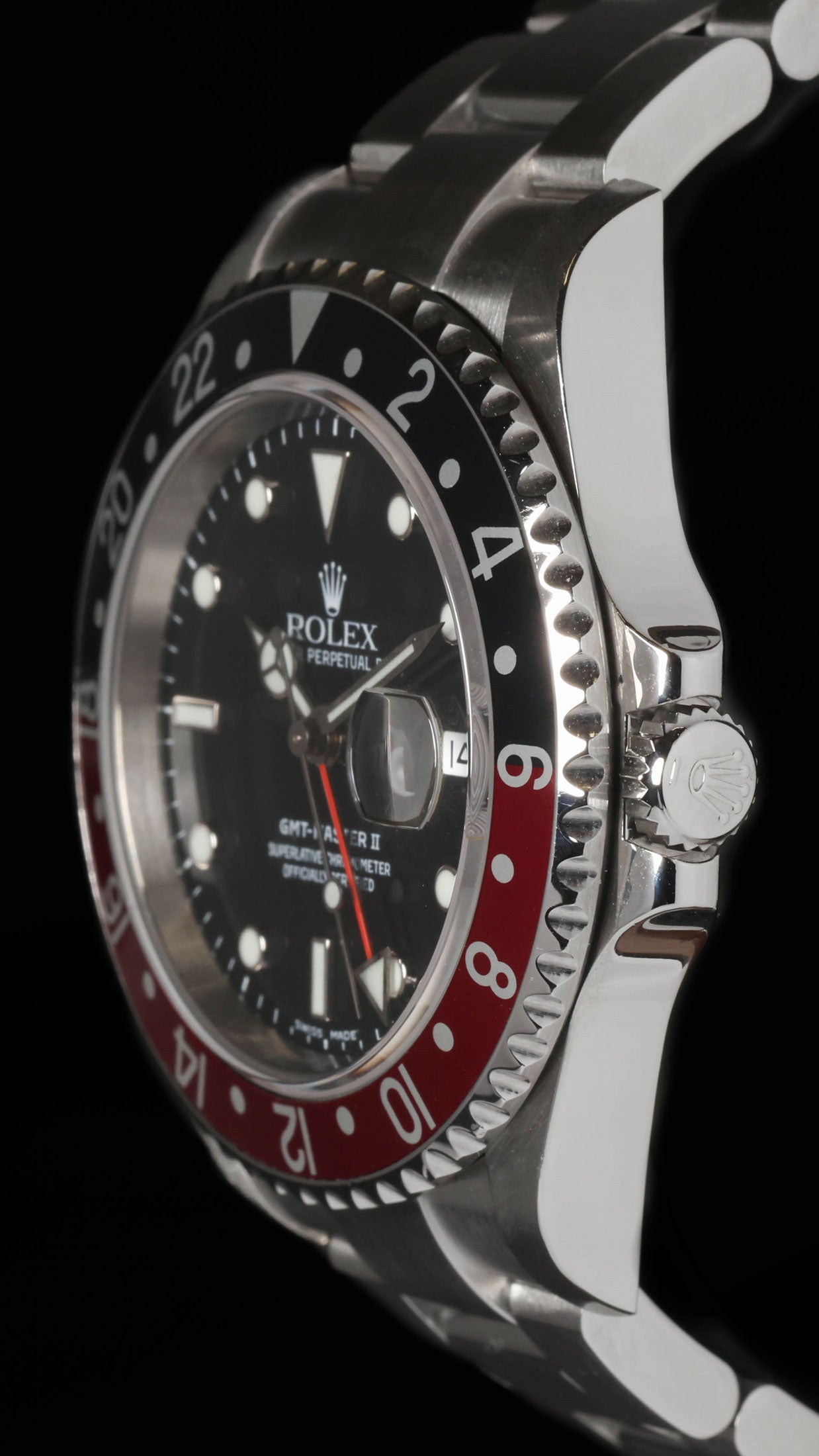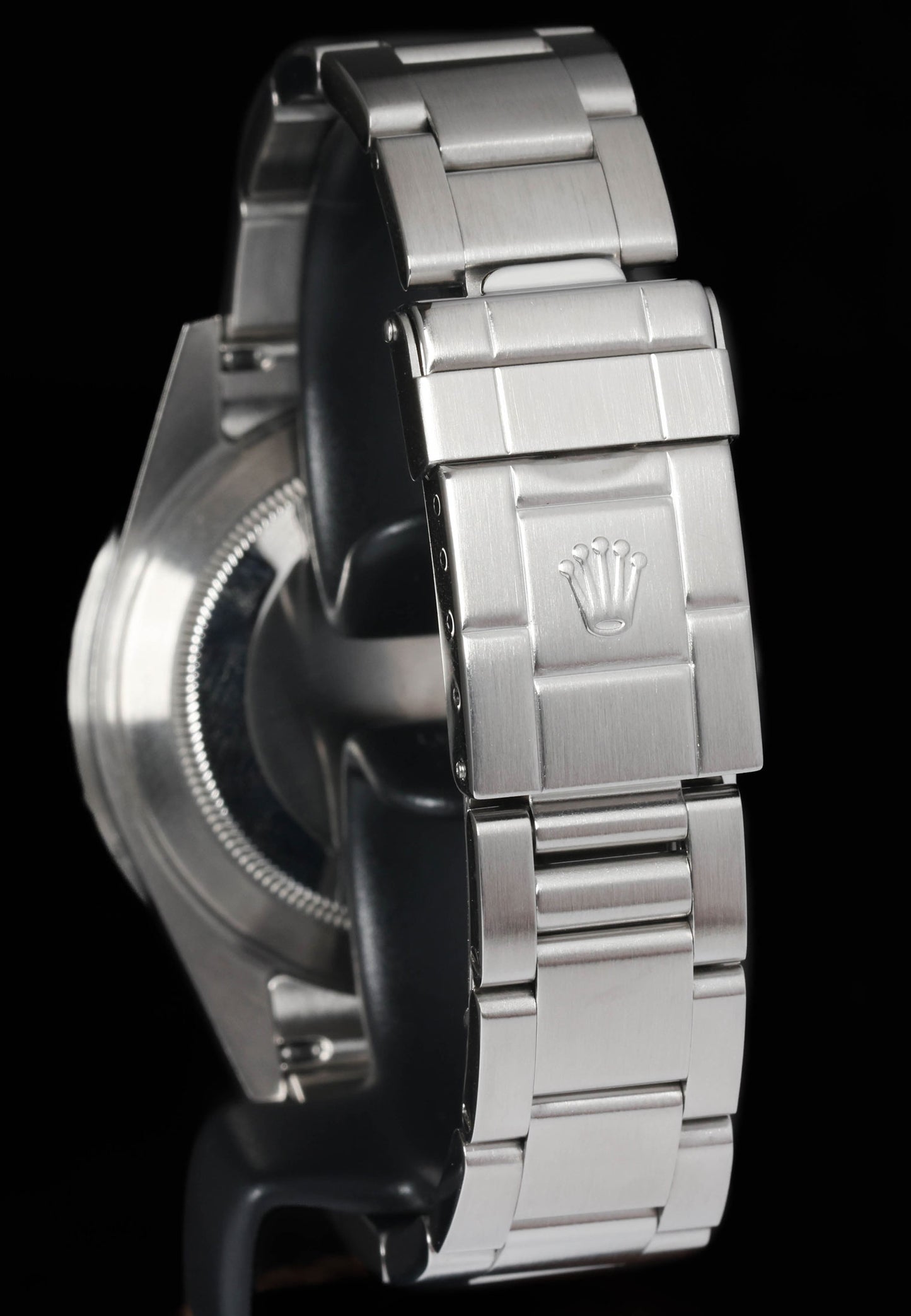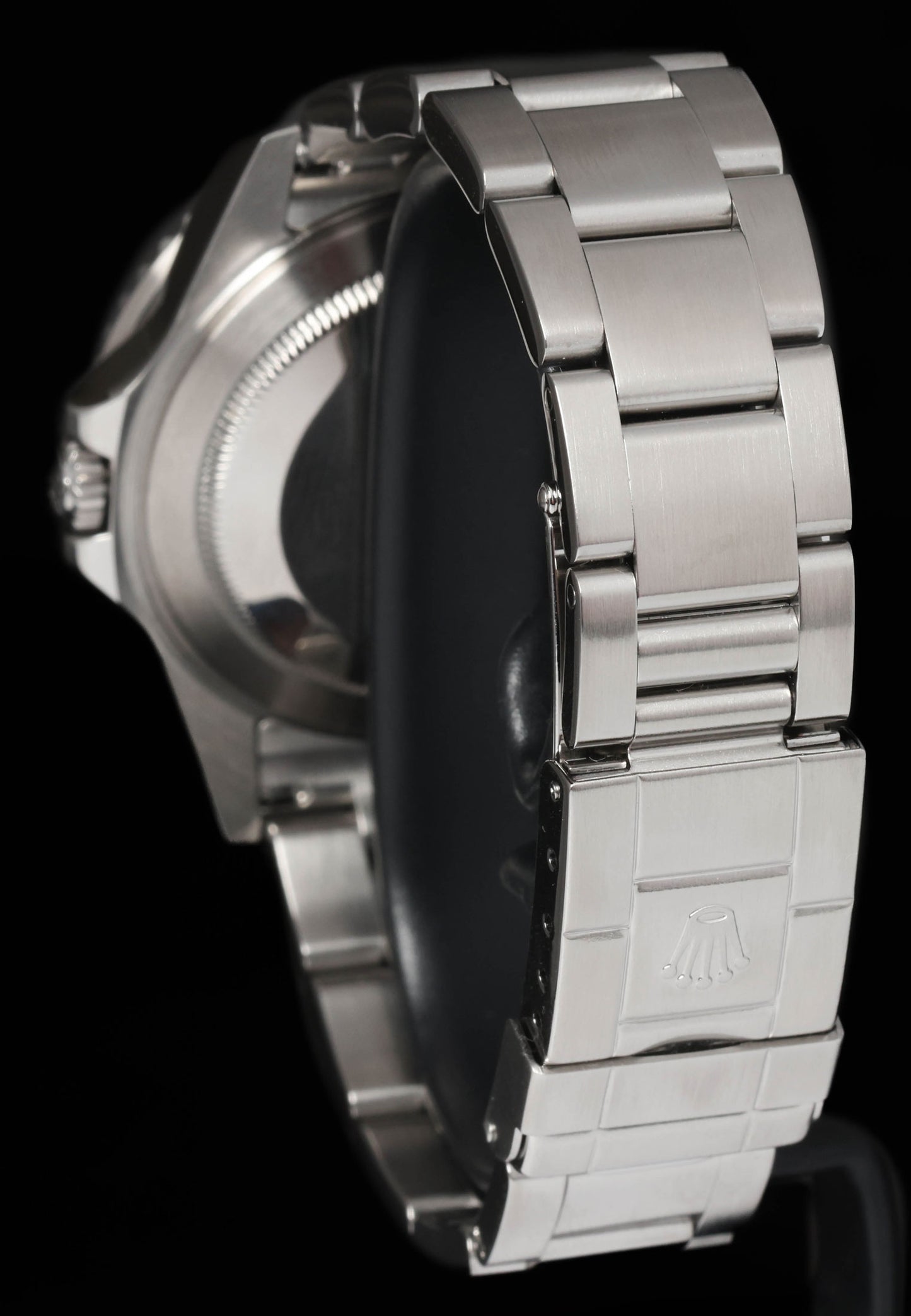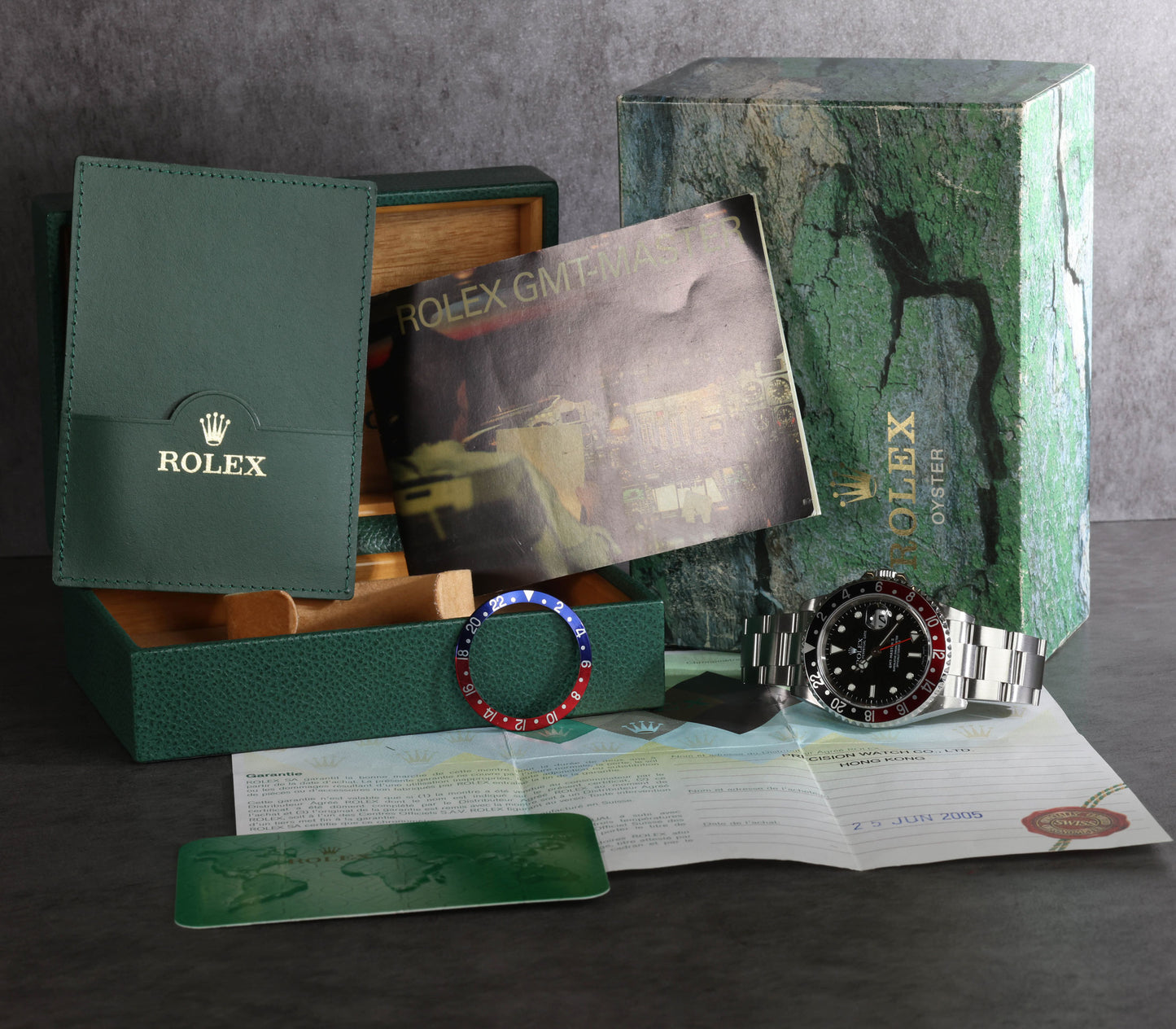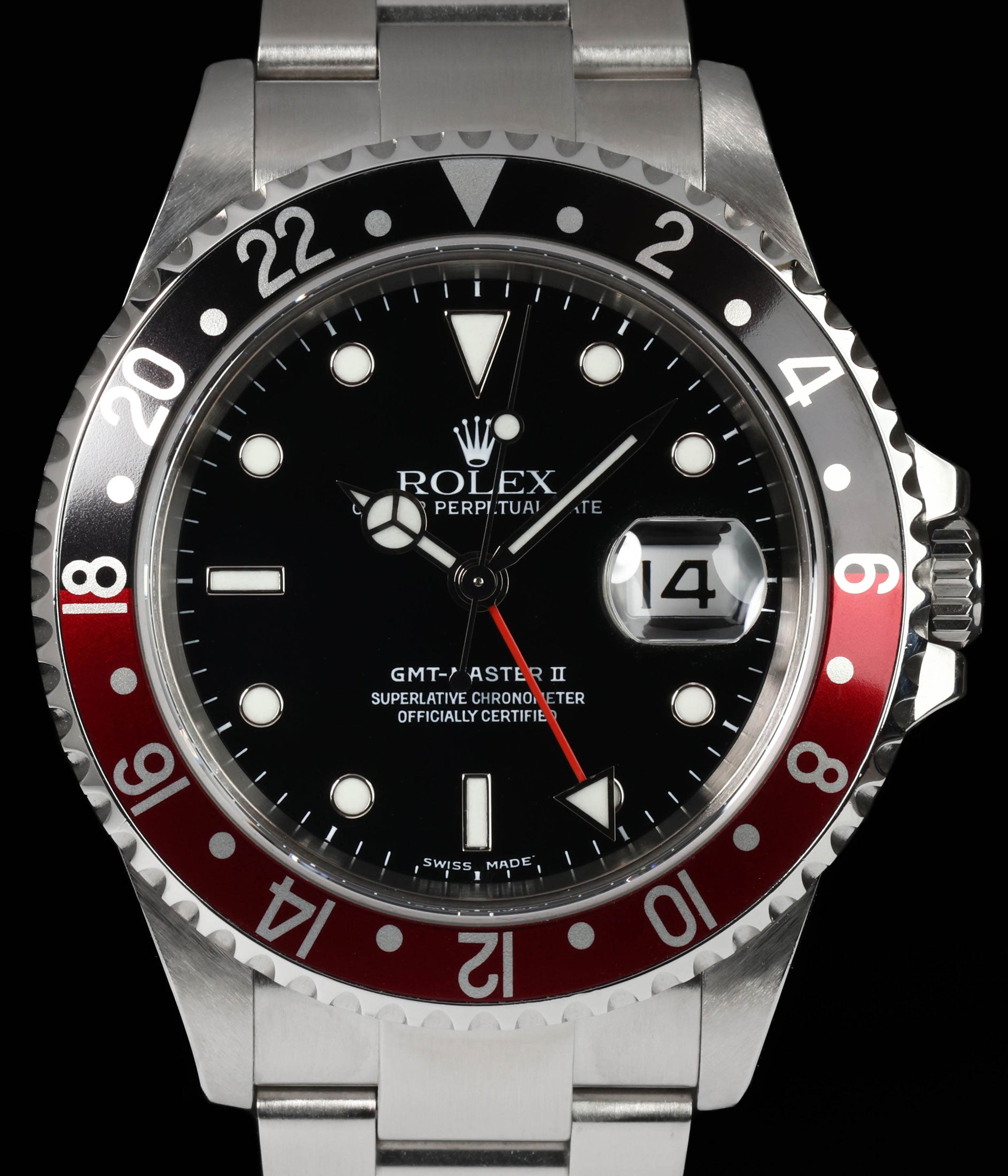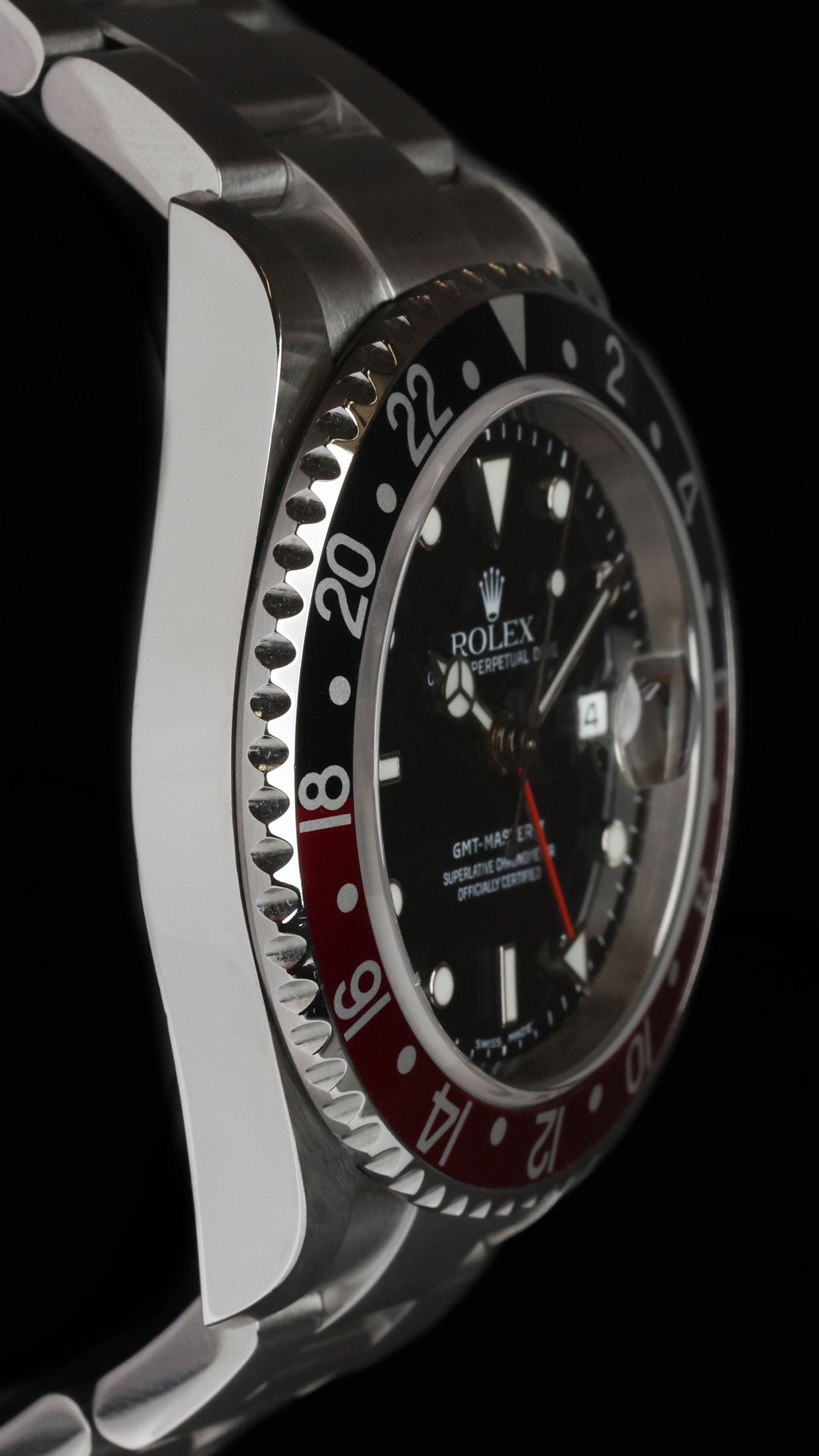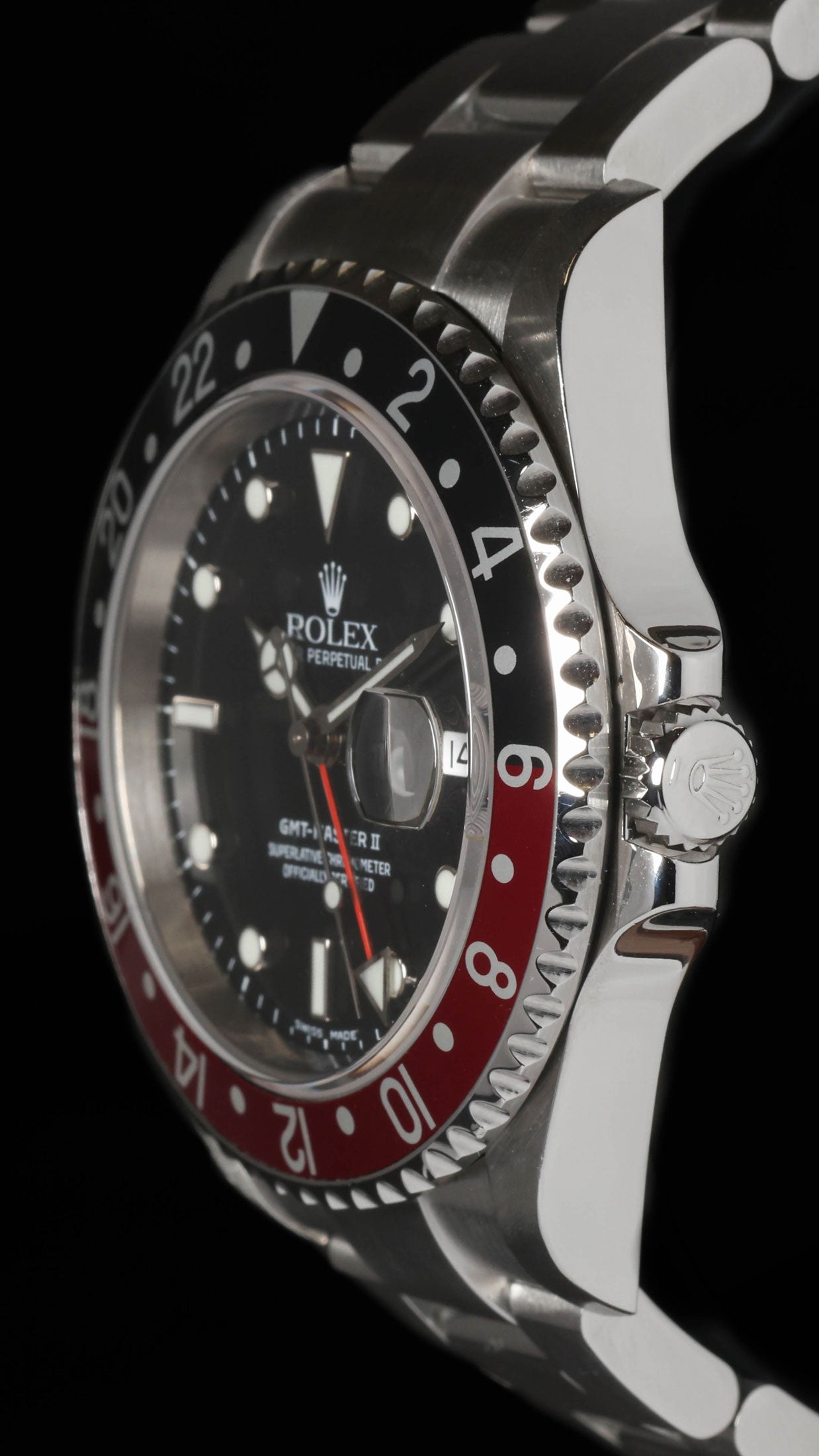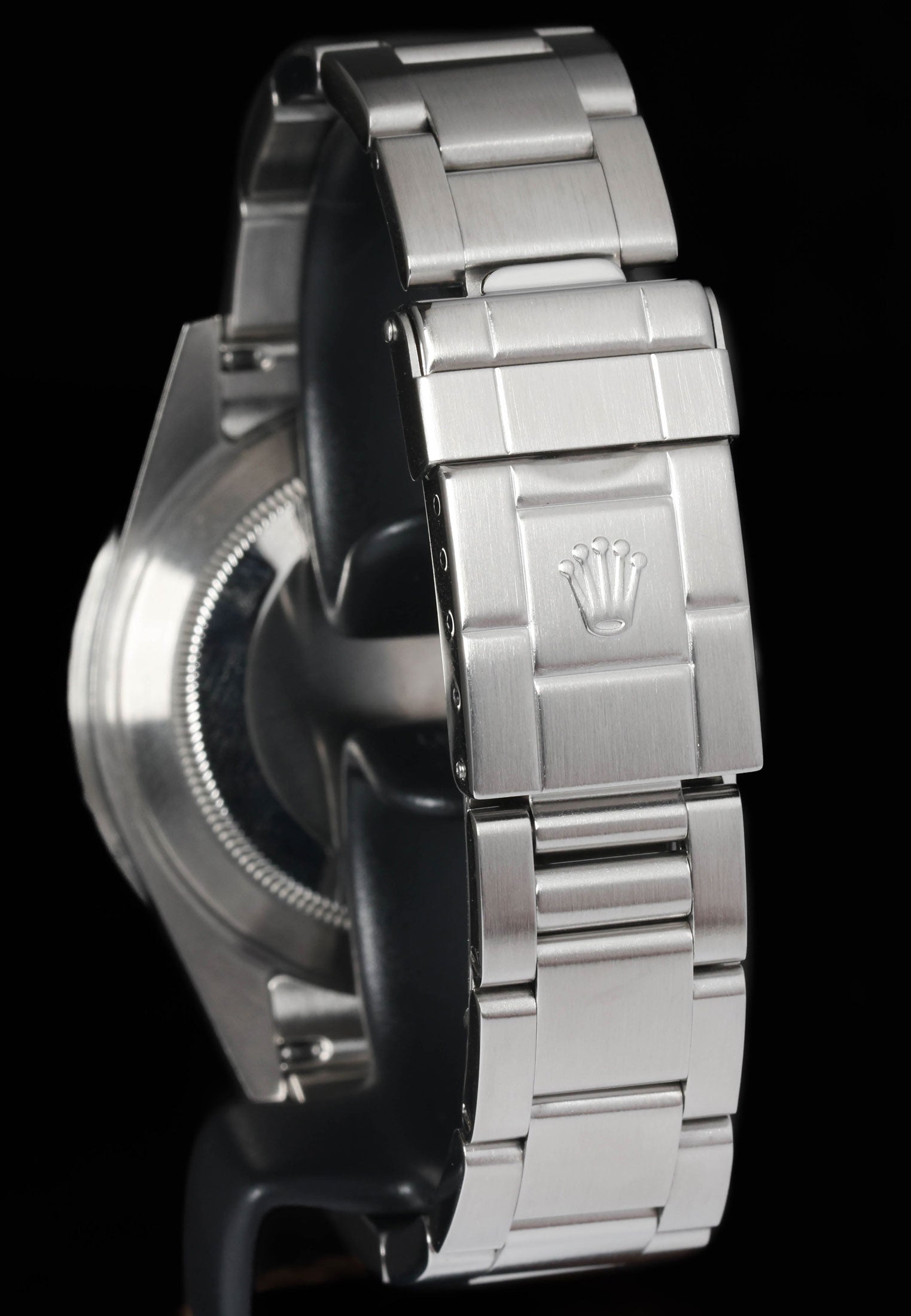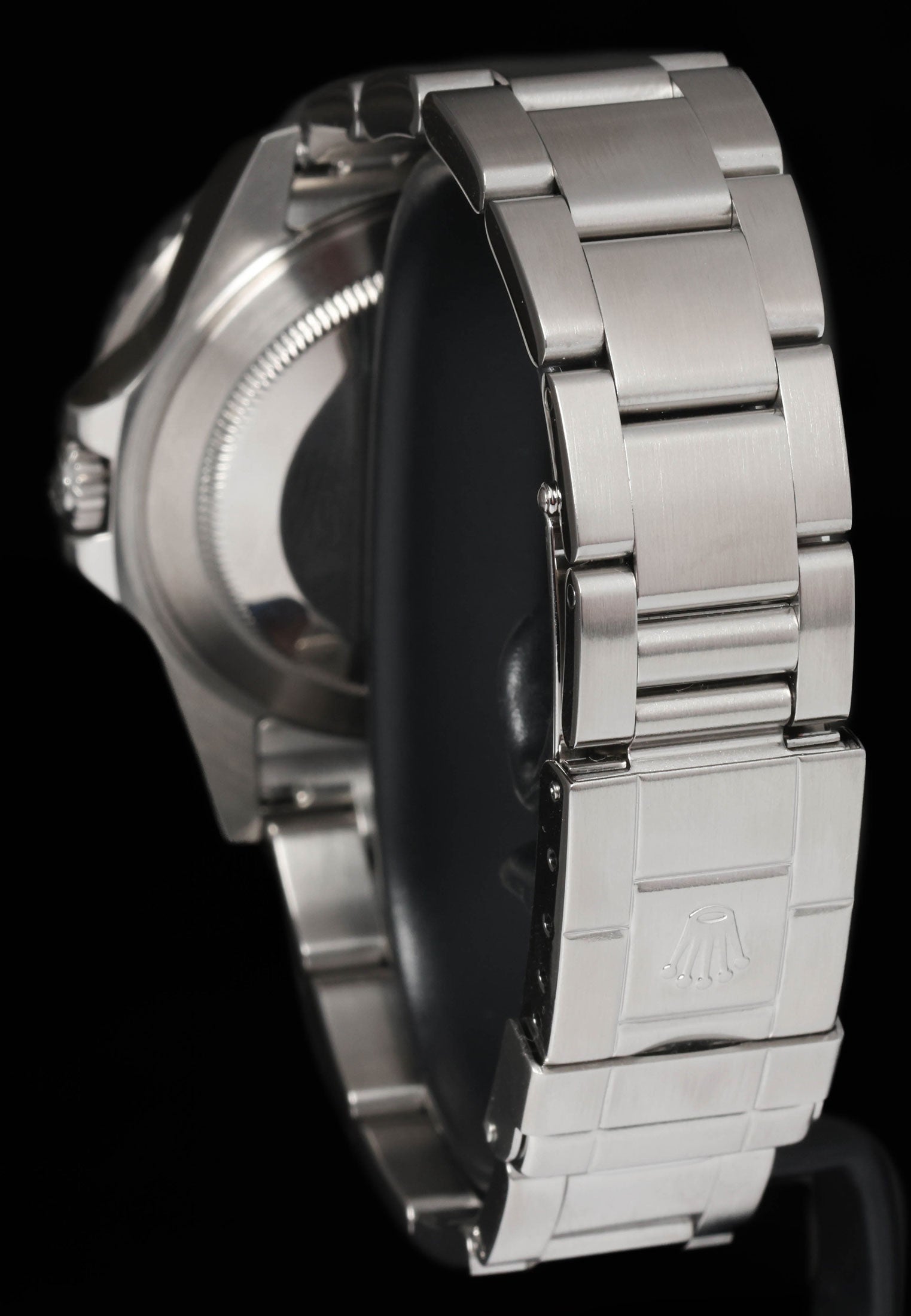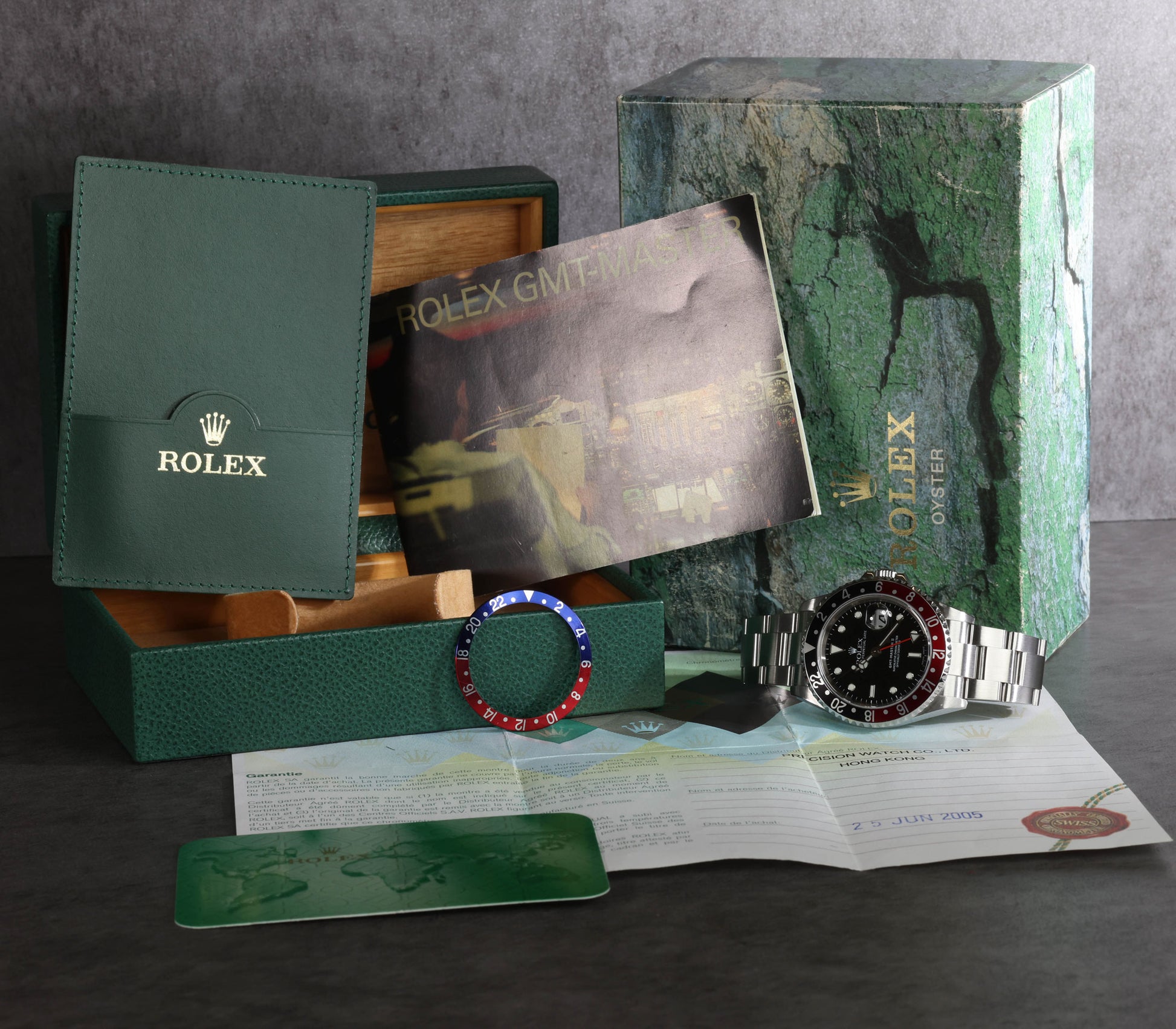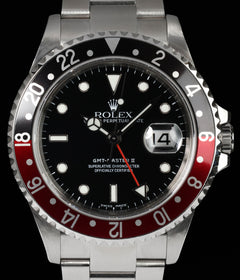Crown Vintage
Rolex GMT Master II 16710 'Coke' 40mm 2004
Rolex GMT Master II 16710 'Coke' 40mm 2004
Couldn't load pickup availability
Rolex GMT Master II 16710 'Coke'
The case and bracelet remain in excellent overall condition, with little to no visible wear. The case exhibits sharp, crisp lines with factory brushing still present, indicating it has not been polished. The Oyster bracelet is equally well preserved, showing no stretch and retaining its original finish. Both the case and bracelet present as exceptionally well cared for, making this a standout example of a late-production 16710.
Share
Why we love this watch
Why we love this watch
Rolex GMT-Master II 16710 ‘Coke’ F Serial: A Modern Classic in the GMT Lineage
Introduction
The Rolex GMT-Master II reference 16710, fitted with the iconic red and black “Coke” bezel and bearing an F serial, represents a compelling bridge between the vintage soul of the original GMT and the technical refinements of the modern era. Produced in the early 2000s, this reference captured the very last years of traditional case proportions and aluminium bezel inserts before Rolex made its sweeping updates to the GMT line. The F-series, in particular, is part of that final wave before the 16710 was discontinued in favour of the ceramic 116710LN.
The red and black bezel combination—nicknamed “Coke” by collectors due to its resemblance to the soft drink’s branding—has long been associated with the GMT-Master II, and although it hasn’t returned in any modern ceramic form, it continues to be one of the most recognisable and beloved iterations of the GMT aesthetic.
This article explores the design, mechanics, functionality and historical relevance of the Rolex GMT-Master II 16710 Coke with an F serial, and how it marked the end of an era before Rolex pivoted into the modern, maxi-case world of ceramic bezels and solid lugs.
The Evolution of the GMT-Master Line
Originally developed in 1954 in collaboration with Pan American Airways, the Rolex GMT-Master was engineered to help pilots track time across multiple time zones. The reference 6542 kicked things off, followed by the long-lived 1675, which introduced crown guards and a more robust construction. The GMT-Master II line arrived in 1983 with reference 16760, famously nicknamed the “Fat Lady” due to its thicker case. It also introduced the independent hour hand, allowing local time to be adjusted without affecting the GMT hand—a significant evolution for world travellers.
By the late 1980s, Rolex released the GMT-Master II 16710, a more refined take on the Fat Lady. It maintained the functionality and aesthetics that had made the GMT so successful, but introduced a slimmer case and more bracelet options. The 16710 remained in production until approximately 2007, with numerous updates made over the years. The F serial models were produced around 2004-2005, and they reflect the culmination of more than two decades of steady refinements.
F Serial Context and Transitional Features
Rolex’s serial number system provides a useful way to date watches, and the F serial falls near the end of the 16710’s production life. Watches with this serial prefix typically include several features that hint at Rolex’s eventual transition into modern specifications.
By the F serial period, Rolex had already begun phasing in “no holes” cases—where the lug holes that had previously been drilled through the sides of the case to access spring bars were removed for a cleaner, more streamlined look. These F serial 16710s were available both with and without lug holes, depending on production timing and configuration, making them interesting transitional models.
Another significant update by this point was the use of the “Rolex ROLEX ROLEX” engraved rehaut (the inner chapter ring around the dial), which started appearing around the Z serial that followed. While most F serial watches still had the clean rehaut without engraving, a few transitional cases may show the earliest examples of Rolex moving toward this modern security feature.
The F serial 16710 “Coke” often came equipped with solid end link (SEL) bracelets, providing more heft and eliminating the play found in earlier folded-link bracelets. These improvements brought the GMT-Master II closer to the durability standards that Rolex would fully embrace in the ceramic models that followed.
Aluminium Coke Bezel Insert
The red and black aluminium bezel insert of the 16710 “Coke” remains one of the most recognisable visual identifiers of this reference. The use of anodised aluminium allowed for vibrant colouration and relatively easy replacement in the event of scratches or fading—unlike the modern ceramic bezels, which are more scratch-resistant but far more difficult to replace.
The red on the Coke bezel is deeper and more saturated than the red used on the later ceramic Pepsi bezels, which appear slightly more muted due to the limitations of ceramic pigment firing. This red/black combination also provides stronger contrast and a bolder look than the blue/red “Pepsi” variant or the all-black insert that was also available on the 16710.
Functionally, the bi-directional bezel allows the wearer to track a third time zone by rotating the bezel to align with the GMT hand. While most users rarely use the bezel this way in everyday life, the visual impact of the two-tone bezel remains key to the GMT’s identity.
Case and Bracelet
The 16710’s case measures 40mm in diameter, with a thickness of approximately 12mm and a lug width of 20mm. These proportions strike a balance between sporty tool-watch capability and understated elegance, especially when compared to the bulkier GMT-Master II ceramic models that followed.
By the F serial run, many examples were fitted with the Oyster 78790A bracelet with solid end links. This was a marked improvement over earlier versions, contributing to a more rigid, refined feel on the wrist. The flip-lock clasp, while not as advanced as today’s Glidelock or Easylink systems, remained highly functional and secure.
Despite lacking the “maxi” case proportions and ceramic bezel, the 16710 F serial still exudes a modern robustness. Its case architecture is sharper and more refined than earlier GMTs like the 1675 or 16750, while still retaining drilled lug cases in some examples—offering a welcome nod to tool-watch practicality.
Dial and Hands
The dial of the F serial GMT-Master II 16710 is a glossy black with applied white gold hour markers filled with Super-LumiNova, as tritium had been phased out by the late 1990s. This offers longer-lasting and more consistent luminescence, though without the warm patina of earlier tritium dials.
The Mercedes-style hands are standard, including the distinctive red 24-hour hand with its arrow tip, which helps in reading the second time zone. These later dials are also known for their crisp printing and well-balanced layout, with “GMT-Master II” printed in red for subtle contrast.
The dial text at 6 o’clock reads “Swiss Made,” denoting the use of Super-LumiNova. Earlier examples had “Swiss-T<25” for tritium. The F serial thus firmly belongs to the modern luminous era of Rolex sports watches.
Movement: Calibre 3185
Powering the 16710 is the Rolex Calibre 3185, a 31-jewel automatic movement with a 50-hour power reserve. It operates at 28,800 vibrations per hour and features hacking seconds, quick-set date, and an independently adjustable hour hand—crucial for travellers needing to set local time without disturbing the 24-hour hand.
The 3185 is a highly regarded movement within the Rolex stable, known for its durability, accuracy and ease of service. It was eventually replaced by the Calibre 3186, which featured a more refined balance bridge and reduced the wiggle in the GMT hand—something only noticeable under specific conditions.
Most F serial 16710s contain the Calibre 3185, though a few transitional examples may house early versions of the 3186. That said, the performance differences between the two are marginal in real-world use.
Versatility and Wearing Experience
Part of what makes the 16710 such a successful design is its versatility. The 40mm size sits comfortably on a wide range of wrist sizes, while the thinner case profile (compared to modern Rolex GMTs) ensures it slides easily under cuffs.
The Coke bezel adds personality without being ostentatious. Unlike the Pepsi’s slightly more playful aesthetic, the Coke’s black and red colour scheme gives it a sportier, more aggressive look. This makes it equally at home with jeans and a T-shirt or a jacket and tie.
Additionally, the 16710 is compatible with multiple bezel inserts and can be swapped with Pepsi or all-black variants if desired—offering a level of customisation not possible with the monobloc ceramic bezels of later models.
Discontinuation and the Ceramic Era
In 2007, Rolex discontinued the 16710 and replaced it with the GMT-Master II 116710LN, which introduced several significant changes: a Cerachrom ceramic bezel, maxi case, larger hands and indices, and the updated Calibre 3186 movement.
While the 116710 offered clear upgrades in terms of materials and legibility, it also represented a departure from the classic proportions and tool-watch charm of the 16710. The transition to the ceramic era marked a shift in Rolex’s priorities—emphasising luxury and wrist presence over discreet functionality.
Notably, the “Coke” bezel has yet to return in any modern ceramic GMT model, making the aluminium-insert 16710 Coke even more distinct as time goes on. Its colour scheme remains unique to this era of GMT-Master II watches.
Final Thoughts
The Rolex GMT-Master II 16710 “Coke” with an F serial stands at a pivotal point in Rolex history—capturing the very end of the aluminium bezel and pre-maxi case era while incorporating modern improvements like Super-LumiNova, solid end links, and improved bracelet architecture.
It represents the last time Rolex blended old-world charm with contemporary performance before the brand turned the GMT into a more polished and luxurious product line. The 16710’s slimmer profile, lighter feel, and versatile 24-hour bezel insert system make it an ideal choice for those who appreciate the classic GMT design without sacrificing durability or everyday wearability.
For those drawn to the aesthetic punch of the red and black “Coke” bezel, there is no modern Rolex equivalent. The F serial models—some of the last of their kind—occupy a unique space in the timeline, offering timeless design and functional excellence in equal measure.
Case & Bracelet
Case & Bracelet
- Case and bracelet in excellent condition.
- Little to no wear on either.
- No bracelet stretch
- Case & bracelet unpolished
Dial & Hands
Dial & Hands
Dial & hands flawless.
Warranty & Condition
Warranty & Condition
Crown Vintage Watches provides a minimum 3-month mechanical warranty on pre-owned watches, from the date of purchase.
The warranty covers mechanical defects only.
The warranty does not cover damages such as scratches, finish, crystals, glass, straps (leather, fabric or rubber damage due to wear and tear), damage resulting from wear under conditions exceeding the watch manufacturer’s water resistance limitations, and damage due to physical and or accidental abuse.
Please note, water resistance is neither tested nor guaranteed.
Shipping and insurance costs for warranty returns to us must be covered by the customer. Returns must be shipped via traceable courier. Return shipment must be pre-paid and fully insured. Collect shipping will be refused. In case of loss or damages, the customer is liable.
Our Pledge
At Crown Vintage Watches, we stand by the authenticity of every product we sell. For added peace of mind, customers are welcome to have items independently authenticated at their own expense.
Condition
Due to the nature of vintage timepieces, all watches are sold as is. We will accurately describe the current condition and working order of all watches we sell to the best of our ability.
Shipping & Refund
Shipping & Refund
